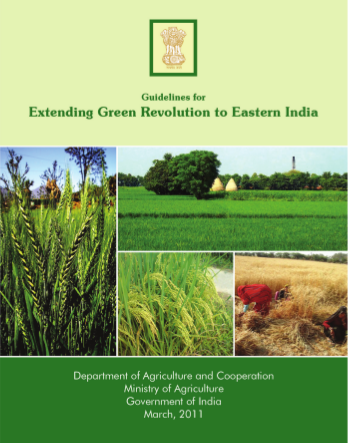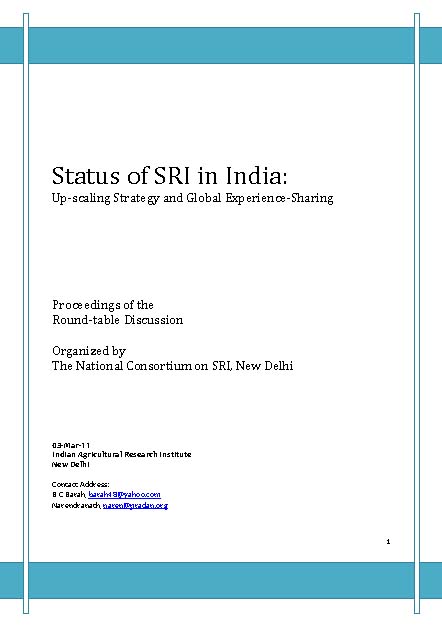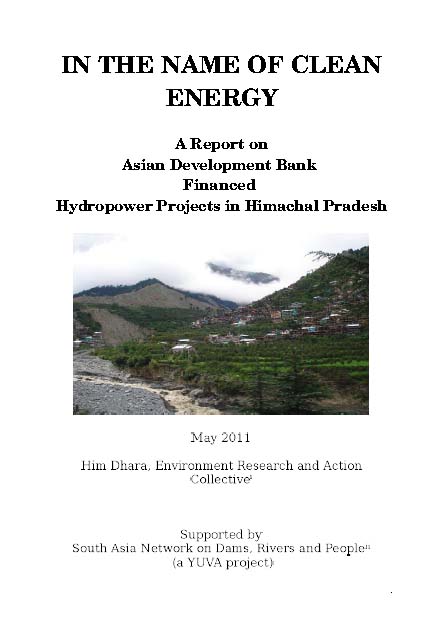/regions/political
Political
Guidelines for extending green revolution to eastern India - Document prepared by Department for Agriculture and Cooperation (2011)
Posted on 27 May, 2011 07:50 AM The states of Assam, Bihar, eastern U.P, Chattisgarh, Jharkhand, Bengal, Orissa were allocated extra funds in the last year for this purpose.
The states of Assam, Bihar, eastern U.P, Chattisgarh, Jharkhand, Bengal, Orissa were allocated extra funds in the last year for this purpose.
Guidelines for rainfed area development programme - Document prepared by Department of Agriculture and Cooperation (2011)
Posted on 27 May, 2011 07:47 AMRainfed areas account for nearly 57 per cent of the agricultural land in India. These areas assume special significance in terms of ecology, agricultural productivity and livelihoods for millions. With proper management, rainfed areas have the potential of contributing a larger share to food grain production.
Guidelines for integrated development of 60,000 pulses villages in rainfed areas - Document prepared by Department of Agriculture and Cooperation (2011)
Posted on 27 May, 2011 07:36 AMThe budget allocates Rs 300 crores under the Rashtriya Krishi Vikas Yojana (RKVY) for this scheme. This project will supplement the ongoing work on pulses development under the National Food Security Mission. There is also an emphasis on building institutions that would provide market linkage to the grower of pulses. The states of M.P, U.P, Karnataka, Andhra Pradesh, Gujarat, Chattisgarh, Bihar, Maharashtra, Orissa, Rajasthan, and Tamilnadu were chosen for this programme. These states together constitute nearly 96% of area where pulses are grown.
Khadkipada, Maharashtra - A tale of development, an account of transformation - A film by WOTR on the Water Channel
Posted on 26 May, 2011 01:42 PM
Exhibition of "Dakshina Pinakini River Mapping and Landscape Survey"- An artistic intervention, 23rd - 26th May, 2011, Bengaluru
Posted on 26 May, 2011 01:23 PMVenue: Venkatappa Art Gallery, Kasthurba road, Bengaluru
Collaborated by: Subramani J, Ravikumar S M Halli & Shivaprasad S
Description:
The study focuses on Bangalore, highlighting its important rivers, lakes and its very lavish natural resources and how it is getting damaged due to its excessive urban growth and ignorance of the people. We started our documentation from Nandi hills to Hosur was our destination. Here we filmed and photographed various aspects of this river, the agricultural landscape and the urban scape. These documentations are archival materials, which have been focused during the process of research. Like how the death of a river takes place, where it used to begin and rebirth of the river due to the excess development of Broad Bangalore’s urban area.
Centre for Science and Environment is looking for Team Head - Renewable Energy Programme
Posted on 26 May, 2011 12:59 PMThe Centre for Science and Environment, a non-profit institution known for its rigorous and scientific policy research and advocacy on environmental issues is looking for a Team Head to steer its Renewable Energy Programme.
Inviting abstracts for documenting flood-induced conflicts in India - Apply by 8th June, 2011
Posted on 26 May, 2011 12:57 PM
The Forum for Policy Dialogue on Water Conflicts in India, a network of organisations and individuals having interest, experience and expertise in understanding conflicts arising around water in the country and exploring options to resolve these water conflicts in the interests of peace and equitable sharing, management and development of water resources. The Forum presently is in its second phase of work and the focus is on conflict documentation, conflict resolution and conflict prevention. Hence, an effort to document flood induced conflicts in India, an issue that has remained unexplored until date. In fact in its first phase the Forum had documented more than 60 cases of different types of water conflicts and this compendium has published by Routledge as a book: Water Conflicts in India: A Million Revolts in the Making.
Status of SRI in India - Upscaling strategy and global experience sharing - A roundtable discussion at IARI
Posted on 26 May, 2011 08:16 AM The issues of sustainable food security assume national importance, as the country is debating on the crucial National Food Security Bill. Breaking yield barrier, accelerating growth of production and ensuring sustainability are the critical policy concerns in Indian agriculture.
The issues of sustainable food security assume national importance, as the country is debating on the crucial National Food Security Bill. Breaking yield barrier, accelerating growth of production and ensuring sustainability are the critical policy concerns in Indian agriculture.
The roundtable discussion underlined the need to harness the opportunities offered by the System of Rice Intensification (SRI) and its extensions to crop production in many areas. This may help in substantially reducing the need for embedded subsidies in every grain of rice while achieving increases in yield by 15 per cent to 40 per cent or more over present conventional methods. In India about 1.7 million farmers are estimated to have adopted the technique on more than 7.5 lakh hectares across 160 districts, without any major project funding so far. Tamil Nadu and Tripura are the leading states for adoption of SRI, but many others are following suit.
In the name of clean energy – A report on Asian Development Bank financed hydropower projects in Himachal Pradesh
Posted on 25 May, 2011 07:06 PM This report by Him Dhara, an environmental research and action collective, deals with the Asian Development Bank financed hydropower projects in Himachal Pradesh, which are leading to obstruction of the rivers and their consequent disappearance for harnessing energy and making ‘judicious’ use of the water. Within the hydro sector the attention has turned to the Indian Himalayan region which is estimated to have seventy nine per cent of the total hydropower potential of the country.
This report by Him Dhara, an environmental research and action collective, deals with the Asian Development Bank financed hydropower projects in Himachal Pradesh, which are leading to obstruction of the rivers and their consequent disappearance for harnessing energy and making ‘judicious’ use of the water. Within the hydro sector the attention has turned to the Indian Himalayan region which is estimated to have seventy nine per cent of the total hydropower potential of the country.
The technology of ‘run of the river’ (ROR) used to tap “the flow of rivers” in high gradient zones to generate power has given impetus to setting up of hydro-projects in the Himalayan states. In India, the mountainous region of the Himalayas offered the “perfect setting” for such projects, with the availability of several flowing water sources that could be tapped before they reached the plains. Of the Himalayan states, after Arunachal Pradesh, Himachal Pradesh is second in line with a hydropower potential of about 21000 MW. The installed capacity has increased twenty fold (from 326 MW to 6370 MW) in the last ten years indicating the frenzied pace of hydropower development in the state.
Short course on Re-Imagining the 'World-Class' city, Indian Institute for Human Settlement, 14th - 18th June, 2011, Bangalore
Posted on 25 May, 2011 03:44 PM Organizer: Indian Institute for Human Settlement (IIHS)
Organizer: Indian Institute for Human Settlement (IIHS)
Venue: Bangalore